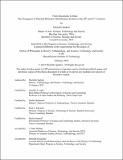From Documents to Data: The Emergence of National Biometric Identification Systems in the 20th and 21st Centuries
Author(s)
Spektor, Michelle
DownloadThesis PDF (30.87Mb)
Advisor
Light, Jennifer S.
Terms of use
Metadata
Show full item recordAbstract
In recent decades, states around the world are increasingly incorporating biometrics – measurements of fingerprints, faces, or other parts of the body – into ID cards, passports, databases and other national identification systems for their own citizens. How did biometric identification transform from a technology primarily aimed at criminals, colonial subjects, and groups at society’s margins, into a technique increasingly preferred by states for identifying and governing their whole citizenries? And how did this shape state-citizen relationships?
To answer these questions, the dissertation considers two recent developments – the UK’s rejection and Israel’s acceptance of proposed national biometric systems in the early 2000s – and contextualizes them within the longer shared history of British and Israeli biometric practices since 1904. By showing how the technological designs, forms of state governance, and notions of individual and national identity inscribed in prior British and Israeli biometric infrastructures influenced subsequent ones, the dissertation argues that national biometric systems are not just technological projects of citizen data collection. They are also political projects of constituting the nation. They link measurements of the body with notions of national belonging – a link that underwrites the exercises of state power that these systems afford, the politics of inclusion and exclusion they entail, and their legitimacy (or illegitimacy) as tools of governance.
Based on archival research, oral history, and ethnographic interviews in the UK and Israel, the dissertation’s five chapters examine how the design and implementation of six different British and Israeli biometric infrastructures biometrized identity and engendered different forms of biometric statecraft between 1904 and 2017. The purposes of these prior systems ranged from eugenics research and measuring population health in the UK in 1904, to colonial policing in Mandatory Palestine between 1918 and 1948, Jewish religious protocols for identifying the dead in the Israeli military since 1974, and surveilling workers from Occupied Palestinian Territories since the 1990s. The chapters also examine the ways social movements influenced the technological design and policy frameworks of proposed national systems in the UK and Israel in the early 2000s. Each of these biometric systems were informed by, and brought into being, different forms of statecraft, state-citizen relationships, and politics of national inclusion and exclusion.
Prior British and Israeli biometric systems technologically and culturally influenced, but did not wholly determine, the UK’s rejection and Israel’s acceptance of national biometric systems in the early 2000s. While new biometric developments in Israel connected biometric identity with emerging forms of Israeli national identity, biometrics in the UK retained their associations with eugenics, colonialism, and national exclusion. British and Israeli technological histories thus serve as sources of insight into current policy questions about biometric systems. These histories show that biometrics have never been neutral, and how past systems’ politics of inclusion and exclusion might endure in future ones. State biometric systems – even as they move through time, place, and political context, and take on new purposes, meanings, and technological forms – raise questions about who is to be included in the system, and therefore in the nation as a whole.
Date issued
2023-02Department
Massachusetts Institute of Technology. Program in Science, Technology and SocietyPublisher
Massachusetts Institute of Technology